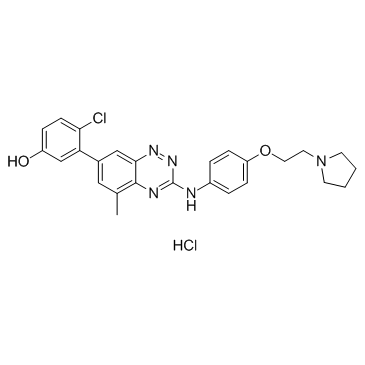TG 100572 (Hydrochloride)
Modify Date: 2025-08-25 12:21:18

TG 100572 (Hydrochloride) structure
|
Common Name | TG 100572 (Hydrochloride) | ||
|---|---|---|---|---|
| CAS Number | 867331-64-4 | Molecular Weight | 512.43100 | |
| Density | N/A | Boiling Point | N/A | |
| Molecular Formula | C26H27Cl2N5O2 | Melting Point | N/A | |
| MSDS | N/A | Flash Point | N/A | |
Use of TG 100572 (Hydrochloride)TG 100572 Hydrochloride is a multi-targeted kinase inhibitor which inhibits receptor tyrosine kinases and Src kinases; has IC50s of 2, 7, 2, 16, 13, 5, 0.5, 6, 0.1, 0.4, 1, 0.2 nM for VEGFR1, VEGFR2, FGFR1, FGFR2, PDGFRβ, Fgr, Fyn, Hck, Lck, Lyn, Src, Yes, respectively. |
| Name | 4-chloro-3-[5-methyl-3-[4-(2-pyrrolidin-1-ylethoxy)anilino]-1,2,4-benzotriazin-7-yl]phenol,hydrochloride |
|---|---|
| Synonym | More Synonyms |
| Description | TG 100572 Hydrochloride is a multi-targeted kinase inhibitor which inhibits receptor tyrosine kinases and Src kinases; has IC50s of 2, 7, 2, 16, 13, 5, 0.5, 6, 0.1, 0.4, 1, 0.2 nM for VEGFR1, VEGFR2, FGFR1, FGFR2, PDGFRβ, Fgr, Fyn, Hck, Lck, Lyn, Src, Yes, respectively. |
|---|---|
| Related Catalog | |
| Target |
VEGFR1:2 nM (IC50) VEGFR2:7 nM (IC50) FGFR1:2 nM (IC50) FGFR2:16 nM (IC50) PDGFRβ:13 nM (IC50) |
| In Vitro | TG 100572 shows sub-nanomolar activity against the Src family as well as RTK such as VEGFR1 and R2, FGFR1 and R2, and PDGFRβ. TG 100572 inhibits vascular endothelial cell proliferation (ED50=610±71 nM) and blocks VEGF-induced phosphorylation of extracellular signal-regulated kinase. TG 100572 induces apoptosis in rapidly proliferating, but not quiescent, endothelial cell cultures[1]. TG 100572 is shown to inhibit hRMVEC cell proliferation, with an IC50 of 610±72 nM. This suggests that TG 100572 has the therapeutic potential to inhibit VEGF function in ocular endothelial cells, a contributing factor to pathological angiogenesis in diseases such as AMD and PDR[2]. |
| In Vivo | Systemic delivery of TG 100572 in a murine model of laser-induced choroidal neovascularization (CNV) causes significant suppression of CNV, but with an associated weight loss suggestive of systemic toxicity[1]. A concentration of 23.4 µM (Cmax) of TG 100572 is reached in 30 min (Tmax)=0.5 h) in the choroid and the sclera. However, the levels of TG 100572 in the retina are relatively low. The half-life of TG 100572 in ocular tissues is very short; hence, the compound is administered topically minimum t.i.d. to maintain appropriate drug levels in the eye. The maximum concentration one can achieve in formulations using TG 100572 is 0.7% w/v[2]. |
| Cell Assay | For proliferation assays, human retinal microvascular EC plated in 96-well cluster plates are cultured for 48 hr in the presence of either TG 100572 (2 nM-5 µM) or DMSO; medium contained 10% FBS, 50 µg/mL heparin, and 50 ng/mL rhVEGF. Cell numbers are then assessed using an XTT-based assay[1]. |
| Animal Admin | Mice: C57BL/6 mice (15-20 g) are dosed i.p. twice daily for 4 days with 5 mg/ kg TG 100572, followed by a single dose on Day 5, 5 hr after which plasma samples are taken, animals euthanized, and eyes explanted. Alternatively, mice are dosed topically with either TG 100572 or related prodrugs (e.g., TG 100801) by delivering a single 10 µL drop to both eyes for a total of two days, and both plasma and eyes harvested prior to or 0.5, 1, 3, 5, or 7 hr after the Day 2 dosing[1]. |
| References |
| Molecular Formula | C26H27Cl2N5O2 |
|---|---|
| Molecular Weight | 512.43100 |
| Exact Mass | 511.15400 |
| PSA | 83.40000 |
| LogP | 6.39030 |
| InChIKey | NVINBIHNVAYEND-UHFFFAOYSA-N |
| SMILES | Cc1cc(-c2cc(O)ccc2Cl)cc2nnc(Nc3ccc(OCCN4CCCC4)cc3)nc12.Cl |
| TG 100572 (Hydrochloride) |